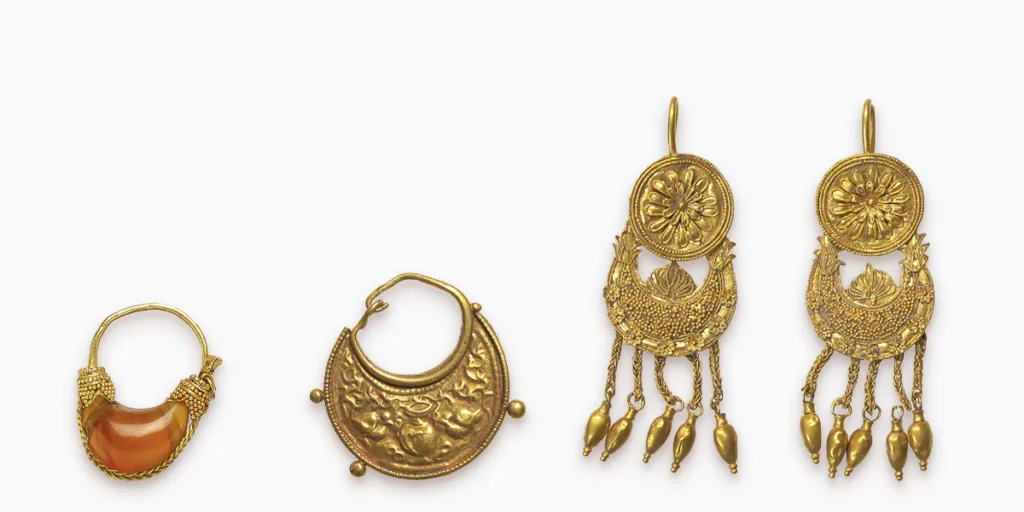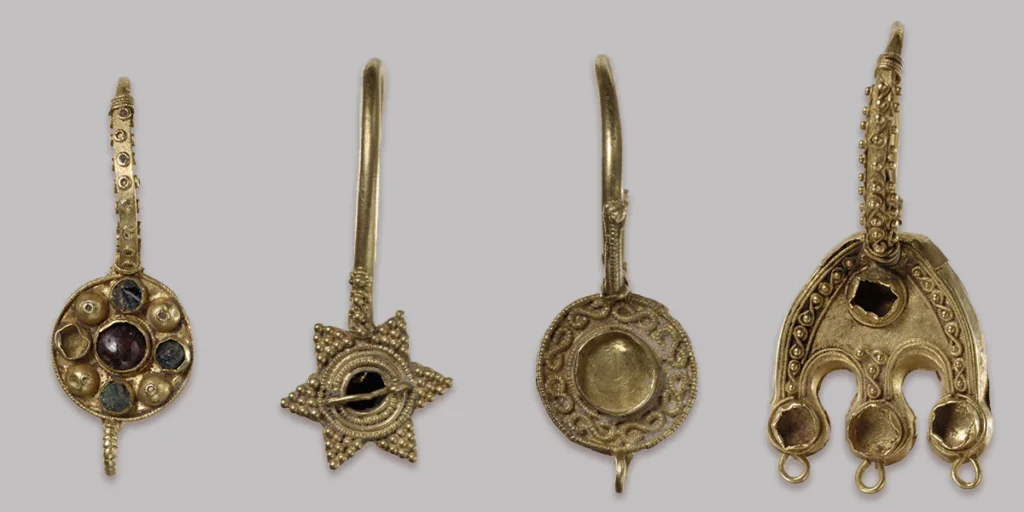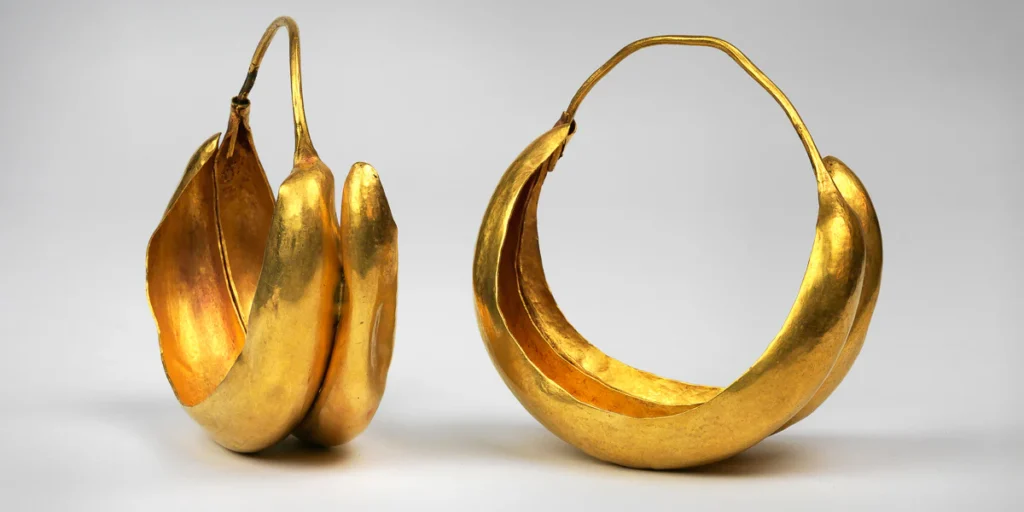Blog
The History of Earrings: From Ancient Times to Modern Fashion
Earrings have been an integral part of human culture for thousands of years, symbolizing everything from status and spirituality to personal expression and fashion. Over the centuries, the styles, materials, and meanings behind earrings have evolved, reflecting the cultural, social, and technological changes of their times.
In this article, we’ll explore the history of earrings, tracing their journey from ancient civilizations to their role as a key accessory in modern fashion.
1. The Origins of Earrings in Ancient Times
Earrings are one of the oldest forms of body adornment, with evidence of their use dating back to prehistoric times. Their significance varied across different cultures, often representing wealth, status, or spiritual beliefs.

1.1. Ancient Mesopotamia and Sumer
- Earrings first appeared around 2500 BCE in Mesopotamia.
- Worn primarily by men as symbols of wealth and power.
- Early designs were made from gold and included hoops or crescent shapes.
1.2. Ancient Egypt
- In Egypt, earrings became popular around 1500 BCE, especially among the elite.
- Designs included elaborate gold hoops and gemstone-encrusted pieces.
- Worn by both men and women, earrings symbolized status and religious devotion.
1.3. Ancient Greece and Rome
- Greek earrings from around 330 BCE were artistic, featuring intricate designs like animal motifs and filigree work.
- In Rome, earrings served as symbols of wealth and luxury. Pearl earrings were especially prized and often worn by wealthy women.
2. The Role of Earrings in Eastern Cultures
In Asia, earrings held significant cultural and spiritual meanings, with styles often reflecting the region’s artistry and craftsmanship.
2.1. India
- Earrings have been part of Indian culture for over 5,000 years, tied to spirituality and status.
- Styles like jhumkas (bell-shaped earrings) and kundan (gemstone-studded designs) remain iconic.
- Earrings were often included in religious ceremonies and marriage rituals.
2.2. China
- In ancient China, earrings were symbols of nobility and elegance.
- During the Han Dynasty (206 BCE–220 CE), jade earrings became popular for their association with purity and immortality.
2.3. Southeast Asia
- Tribal communities used earrings as markers of age, marital status, and social hierarchy.
- Stretching earlobes with heavy earrings was common, symbolizing wisdom and maturity.
3. Earrings in the Middle Ages
The Middle Ages (500–1500 CE) saw a decline in the popularity of earrings in Europe due to religious and social norms.

3.1. Decline in Popularity
- The rise of Christianity discouraged adornments like earrings, which were considered vain.
- Women’s hairstyles and clothing often covered the ears, reducing the demand for earrings.
3.2. Exceptions in the Middle East
- In contrast, earrings remained popular in Middle Eastern and Islamic cultures.
- Gold and gemstone earrings were symbols of wealth and were often given as gifts during weddings or celebrations.
4. The Renaissance and Baroque Eras: A Revival of Earrings
The Renaissance (1300–1600 CE) brought a renewed interest in art and adornment, including earrings.
4.1. Renaissance Style
- Earrings became more visible as women began wearing hairstyles that exposed the ears.
- Designs featured pearls, gemstones, and intricate metalwork.
- Hoop earrings and drop earrings gained popularity during this period.
4.2. Baroque Era (1600–1750 CE)
- The Baroque era saw a love for opulence and extravagance, reflected in earring designs.
- Chandelier earrings, featuring cascading rows of gemstones, became a fashion statement.
- Earrings were often paired with elaborate necklaces and hair ornaments.
5. The 18th and 19th Centuries: Earrings in the Age of Elegance
The 18th and 19th centuries marked significant changes in earring trends, driven by shifting fashion styles and technological advancements.
5.1. Georgian Era (1714–1837 CE)
- Earrings were ornate, featuring diamonds, emeralds, and other precious stones.
- Girandole earrings, with three dangling tiers, were a hallmark of this era.
5.2. Victorian Era (1837–1901 CE)
- Queen Victoria’s influence shaped jewelry trends, including earrings.
- Early Victorian designs featured romantic motifs like hearts, flowers, and bows.
- Mourning earrings, often made from black jet or onyx, became popular after Prince Albert’s death.
6. 20th Century: The Democratization of Earrings
The 20th century saw earrings evolve from symbols of wealth to mainstream fashion accessories, thanks to industrial advancements and changing societal norms.
6.1. Early 20th Century
- Art Nouveau (1890–1910): Delicate, nature-inspired designs with flowing lines and enamel work.
- Art Deco (1920s–1930s): Bold geometric shapes, vibrant colors, and luxurious materials like platinum and diamonds.
6.2. Mid-20th Century
- The rise of costume jewelry made earrings accessible to the masses.
- Clip-on earrings became popular, as pierced ears were less common.
- Designs reflected the trends of the time, such as minimalist styles in the 1950s and bold, colorful pieces in the 1960s.
6.3. Late 20th Century
- The 1970s embraced bohemian and ethnic-inspired earrings, such as hoops and tassels.
- The 1980s introduced oversized and flashy earrings, often worn as statement pieces.
- Pierced ears regained popularity, with stud earrings becoming a staple.
7. Earrings in the 21st Century: Modern Fashion
The 21st century has brought unprecedented diversity in earring styles, materials, and designs.
7.1. Personalized Styles
- Customization and personalization have become key trends, with monogrammed or birthstone earrings gaining popularity.
7.2. Sustainable Jewelry
- Eco-conscious consumers favor earrings made from recycled materials or ethically sourced gemstones.
7.3. Technology Meets Jewelry
- Smart earrings equipped with health monitors or Bluetooth connectivity are emerging.
7.4. Global Influence
- Social media and global travel have introduced people to earring styles from different cultures, such as Indian jhumkas or African beaded earrings.
8. Iconic Earring Trends Through the Ages
Hoops
- Originated in ancient Mesopotamia and remain a timeless favorite.
- Represented power and identity in African and Latin cultures.
Studs
- Simple and elegant, studs became a staple in the 20th century and are now a universal favorite.
Chandelier Earrings
- Popular in the Baroque era and revived in modern formal wear.
Asymmetrical Earrings
- A contemporary trend that challenges traditional symmetry.
9. The Cultural Significance of Earrings
Earrings have always carried deeper meanings beyond fashion:
- Spiritual Protection: Worn to ward off evil spirits in ancient cultures.
- Social Status: Symbolized wealth and rank in many societies.
- Rebellion: Punk and goth subcultures in the 1970s and 80s used earrings as symbols of defiance.
Conclusion
The history of earrings is a fascinating journey through time, reflecting humanity’s evolving cultures, aesthetics, and values. From the ancient gold hoops of Mesopotamia to the bold statement earrings of today, earrings have consistently held a place of importance in self-expression and style.
As we move forward, earrings will continue to evolve, embracing innovation while paying homage to their rich history. Whether you favor timeless studs or avant-garde designs, earrings remain a powerful way to tell your story.


